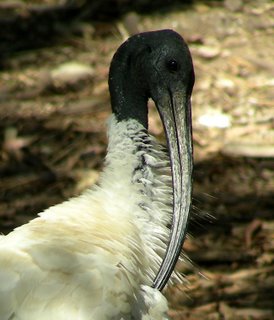 White ibis (Threskiornis molucca) have done very well out of the city sprawl. Whereas many other native birds have suffered from the rise in human population, white ibis have boomed. Like the silver gull—another urban increaser—they've done well from the crap we chuck out. They've abandoned the hard work of hunting for grubs in grasslands in favour of pre-packaged take away. Rubbish tips are dotted with ibis using their long, curved bills to rip open plastic bags. They prowl parks in search of unattended picnics. Small children are subjected to their stand-over tactics. The bare black head and neck give the birds a sinister appearance. That beak does double duty as an offensive weapon.
White ibis (Threskiornis molucca) have done very well out of the city sprawl. Whereas many other native birds have suffered from the rise in human population, white ibis have boomed. Like the silver gull—another urban increaser—they've done well from the crap we chuck out. They've abandoned the hard work of hunting for grubs in grasslands in favour of pre-packaged take away. Rubbish tips are dotted with ibis using their long, curved bills to rip open plastic bags. They prowl parks in search of unattended picnics. Small children are subjected to their stand-over tactics. The bare black head and neck give the birds a sinister appearance. That beak does double duty as an offensive weapon. And after a tough day of menacing and scavenging and generally behaving as if they're on the set of Lock, Stock and Two Smoking Barrels, the ibis return to rookeries on nearby wetlands. It's not difficult to locate a colony. The skeins of birds flying overhead are a bit of a give away but if you don't see any, just follow your nose. Hundreds of digestive tracts emptying their contents into shallow water give the area a distinctive odour.
And after a tough day of menacing and scavenging and generally behaving as if they're on the set of Lock, Stock and Two Smoking Barrels, the ibis return to rookeries on nearby wetlands. It's not difficult to locate a colony. The skeins of birds flying overhead are a bit of a give away but if you don't see any, just follow your nose. Hundreds of digestive tracts emptying their contents into shallow water give the area a distinctive odour. White ibis are widespread in eastern and northern Australia and are becoming more abundant in the west. Two other species occur in Australia—straw-necked ibis (Threskiornis spinicollis) and glossy ibis (Plegadis falcinellus). All three occupy much the same range but glossy ibis are encountered much less frequently in the south. It's a treat to see them around.
White ibis are widespread in eastern and northern Australia and are becoming more abundant in the west. Two other species occur in Australia—straw-necked ibis (Threskiornis spinicollis) and glossy ibis (Plegadis falcinellus). All three occupy much the same range but glossy ibis are encountered much less frequently in the south. It's a treat to see them around.It won't be long before the white ibis take over the country. They've mastered robbery under wings. And it seems that they've now worked out how to march in formation.